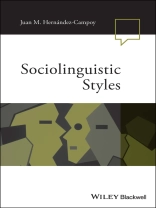Sociolinguistic Styles presents a new and in-depth, historically rooted overview of the phenomenon of style-shifting in sociolinguistic variation. Written by an internationally acclaimed expert in the field, the text explores why, where and when it occurs.
* Full examination of the complex phenomenon of style-shifting in sociolinguistics, focusing on its nature and social motivations, as well as on the mechanisms for its usage and its effects
* In-depth, up-to-date critical overview of the different theoretical approaches accounting for stylistic variation, exploring their historical roots not only in sociolinguistics and stylistics or semiotics but also in classical fields such as rhetoric and oratory
* Coverage of a wide range of related concepts and issues, from the oldest Greek ethos and pathos or Roman elocutio and pronuntiatio to the contemporary enregisterment, stylisation, stance, or crossing
* Written by an academic who has been instrumental in developing theory in this area of sociolinguistics
สารบัญ
Series Editor’s Preface
Acknowledgements
List of Figures
List of Tables
Introduction
PART I: THE CONCEPT AND NATURE OF STYLE
1. The Concept of Style
1.1 Style in Rhetoric
1.1.1. Ancient Greece
1.1.2. The Roman World
1.1.3. Middle Ages and Modern Times
1.2. Style in Stylistics and Semiotics
1.2.1. Textualists: Formalist Stylistics
1.2.2. Contextualists: Functionalist Stylistics
1.2.3. Recent Developments
1.3. Style in Sociolinguistics
2. The Nature of Style
2.1. The Linguistic Meaning of Style: Resources and Mechanisms
2.1.1. Style, Register and Diaphasic Variation
2.1.2. Style, Dialect and Accent
2.1.3. Style and Genre
2.1.4. Style, Register, Slang, Cant and Jargon
2.1.5. Stylistic Devices
2.1.6. Style and the Study of Language Change
2.2. The Social Meaning of Style: Motivations
II.2.1. Style and Identity
II.2.2. Style and Ideology
PART II: SOCIOLINGUISTIC MODELS OF STYLE-SHIFTING
3. Situation-centred Approach: Attention Paid to Speech
3.1. Social Determinism and Positivism
3.1.1. Sociolinguistic Tenets
3.1.2. Sociolinguistic Patterns
3.2. The Formality Continuum
3.2.1. Casual Style
3.2.2. Formal Style
3.2.3. Passage Reading Style
3.2.4. Word List Style
3.2.5. Minimal Pairs Style
3.2.6. The Style Decision Tree
3.3. Audio-monitoring: The Universal Factor
3.3.1. The Principle of Graded Style-shifting
3.3.2. The Principle of Range of Variability
3.3.3. The Principle of Socio-stylistic Differentiation
3.3.4. The Principle of Sociolinguistic Stratification
3.3.5. The Principle of Stylistic Variation
3.3.6. The Principle of Attention
3.3.7. The Vernacular Principle
3.3.8. The Principle of Formality
3.4. Limitations
4. Audience-centred Approach: Audience Design
4.1. Behaviourism and Social Psychological Theories
4.1.1. Language Attitudes
4.1.2. Social Identity Theory and Linguistic Marketplace
4.1.3. Communication Accommodation Theory
4.2. Bakhtin and Dialogism
4.2.1. Centripetal and Centrifugal Forces
4.2.2. Heteroglossia and Multiple Voicing
4.2.3. Addressivity and Response
4.3. The Style Axiom: Audienceship and Responsiveness
4.3.1. Relational Activity
4.3.2. Sociolinguistic Marker
4.3.3. Responsiveness and Audienceship
4.3.4. Linguistic Repertoire
4.3.5. Style Axiom
4.3.6. Accommodative Competence
4.3.7. Discoursal Function
4.3.8. Initiative Axis
4.3.9. Referee Design
4.3.10. Field and Object of Study
4.4. Limitations
5. Context-centred Approach: Functional Model
5.1. Contextualism and the Context of Situation
5.2. Systemic Functional Model of Language
5.3. Polylectal Grammar
5.4. The Register Axiom
5.5. Limitations
6. Speaker-centred Approach: Speaker Design
6.1. Social Constructionism
6.1.1. Phenomenology
6.1.2. Relativism
6.2. Social Constructionist Sociolinguistics: Persona Management
6.2.1. Indexicality, Social Meaning and Enregisterment
6.2.2.Agency
6.2.3. Performativity, Stylisation and Identity Construction
6.2.4. Stance
6.2.5. Authenticity
6.2.6. Hyperdialectism vs. Hyper-vernacularisation
6.2.7. Crossing
6.3. Limitations
7. Conclusion
References
Index
เกี่ยวกับผู้แต่ง
Juan M. Hernández-Campoy is Professor in Sociolinguistics at the University of Murcia, Spain. His books include Style-Shifting in Public (with J.A. Cutillas-Espinosa, 2012), Diccionario de Sociolingüística (with P. Trudgill, 2007), Metodología de la Investigación Sociolingüística (with M. Almeida, 2005), and??Geolingüística (1999). He is the co-editor with J.C. Conde-Silvestre of The Handbook of Historical Sociolinguistics (Wiley-Blackwell, 2012).












